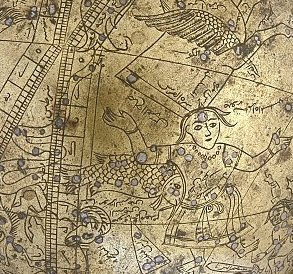There was a 64 day long precessional distance down to Ain from the time of rongorongo, when Sirrah (α Andromedae) had reached 0h:
... Alpheratz, Alpherat, and Sirrah are from the Arabians' Al Surrat al Faras, the Horse's Navel, as this star formerly was associated with Pegasus, whence it was transferred to the Woman's hair; and some one has strangely called it Umbilicus Andromedae. But in all late Arabian astronomy taken from Ptolemy it was described as Al Rās al Mar'ah al Musalsalah, the Head of the Woman in Chains ... In rongorongo times θ Piscis Austrini therefore rose with the Sun in February 14 (45) instead of in DECEMBER 12 (346). It was 64 days later (45 + 365 = 410 and 410 - 346 = 64). A 'Heart' (or 'Navel'; Umbilicus, Pito) for the calendar cycles could evidently have been defined from θ at the belly of the Southern Fish (Piscis Austrini or Piscis Notius):
I have assigned the name pito to a rather rare type of glyph which might have corresponded to the Egyptian nefer:
It does not occur in the G text but in C we can find one specimen (indeed the prototype I have preferred to use as an example):
Notably the star Al Tarf (the End, here for β Cancri) could have been used to integrate the cycle of Venus with the good (sa'ad) 'Navel' or 'Heart': ... In the center between Al Tarf and Al Sharas was right ascension day (124 + 168) / 2 = 146 = 292 / 2 = 584 / 4, where Ras Elaset Australis (the Southern Head of the Lion) rose with the Sun ...
A conclusion seems unavoidable: All Hearts' Day was defined from the position of a cardinal (heart) point among the stars which coincided with the origin of a new year in leaf - a position which in a calendar with heliacal Sirius fixed to the last day in June would have been given a date which steadily was moving ahead. At the time of Ain this 'navel' for the year in leaf would have been in DECEMBER 12, i.e. 266 days after 0h (= 266 days after heliacal Ain). But at the time of rongorongo the star at 0h was Sirrah and θ Piscis Austrini was therefore rising with the Sun 330 days later, because 266 + 64 = 330. Therefore the sacred cosmogram for the foundation of the new year should have been completed in February 14 (2-14). ... On February 9 the Chorti Ah K'in, 'diviners', begin the agricultural year. Both the 260-day cycle and the solar year are used in setting dates for religious and agricultural ceremonies, especially when those rituals fall at the same time in both calendars. The ceremony begins when the diviners go to a sacred spring where they choose five stones with the proper shape and color. These stones will mark the five positions of the sacred cosmogram created by the ritual. When the stones are brought back to the ceremonial house, two diviners start the ritual by placing the stones on a table in a careful pattern that reproduces the schematic of the universe. At the same time, helpers under the table replace last year's diagram with the new one. They believe that by placing the cosmic diagram under the base of God at the center of the world they demonstrate that God dominates the universe. The priests place the stones in a very particular order. First the stone that corresponds to the sun in the eastern, sunrise position of summer solstice is set down; then the stone corresponding to the western, sunset position of the same solstice. This is followed by stones representing the western, sunset position of the winter solstice, then its eastern, sunrise position. Together these four stones form a square. They sit at the four corners of the square just as we saw in the Creation story from the Classic period and in the Popol Vuh. Finally, the center stone is placed to form the ancient five-point sign modern researchers called the quincunx ... Later on in this series of rituals, the Chorti go through a ceremony they call raising the sky. This ritual takes place at midnight on the twenty-fifth of April and continues each night until the rains arrive. In this ceremony two diviners and their wives sit on benches so that they occupy the corner positions of the cosmic square. They take their seats in the same order as the stones were placed, with the men on the eastern side and the women on the west. The ritual actions of sitting down and lifting upward are done with great precision and care, because they are directly related to the actions done by the gods at Creation. The people represent the gods of the four corners and the clouds that cover the earth. As they rise from their seats, they metaphorically lift the sky. If their lifting motion is uneven, the rains will be irregular and harmful ... Possibly there was another 'navel' in April 25:
|
||||||||||||||||||||||||||||||||||||||||||||||||||||||||||||||||||||||||||||||||||||||||||||||||||||||||||||||||||||||||||||||||||||||||||||||||||||||||||||||||













